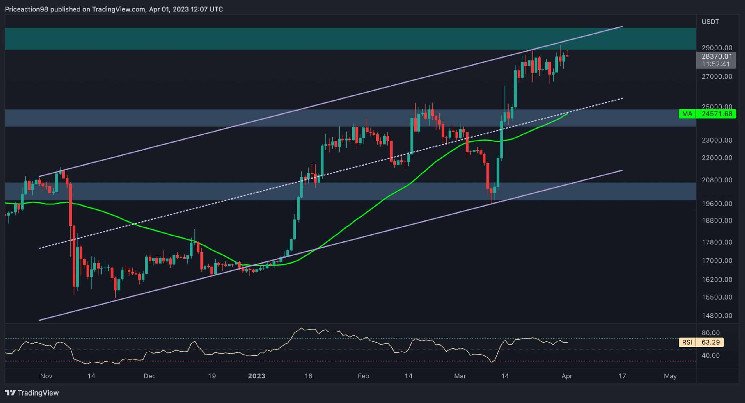
The year 2022 turned out to be difficult for both bitcoin and the entire crypto market. A series of collapses and crashes negatively affected the exchange rates of most coins and tokens. The crypto industry is associated with constant changes, experienced members of the crypto community are no longer surprised by new crises and problems, because they happen constantly and there is no escape from them.
Since the new year has come, it's time to make predictions for the future. In this article, we will analyze the factors that affect the bitcoin exchange rate and its cycle, the methods of analysis on the basis of which forecasts are made, as well as expert opinions.
Let's recall what happened with bitcoin in
2022, 2022 began with $46,000, to which the rate went down after reaching a new historical maximum, which was in November 2021.
Bitcoin did not last long at this level and quickly descended. An important role was played by the temporary shutdown of miners in Kazakhstan, which occurred due to a power outage during protests in the country.

The exchange rate ranged from $48,000 to $36,000 until April came. In the spring, the price decline was first caused by an increase in interest rates by the US Federal Reserve, and after the collapse of the Terra ecosystem. Since June 10, the exchange rate has not returned to $30,000 and until November ranged from $24,500 to $20,000.
In November, a new stage of decline began, which provoked the scandal with Sam Bankman-Freed in the title role. The bankruptcy of FTX and other exchanges and platforms, which FTX pulled, threw bitcoin from the $20,000 level to $16,000-$18,000.
On December 31, 2022, bitcoin was worth $16,603. Starting from January 9, 2023, the price began to rise and reached $18,244 by January 12.
On the 16th, the price is at the level of $20,800.
We remembered what happened with bitcoin in 2022, so let's move on to what awaits us in the new year. It is important not to forget that any assumptions and forecasts may not come true due to unforeseen circumstances, as happened in 2022. Keep this in mind when planning investment decisions.
What affects the bitcoin exchange rate
If we simplify the mechanism that affects the price of bitcoin as much as possible, it turns out that the rate depends on supply and demand, but the most important thing is what is behind supply and demand.
Supply and demand appear for a reason, they are caused by various factors that affect investors. These factors can be divided into short-term and long-term. For example, every year cryptocurrencies grow by the Christmas holidays.
This factor is short-term, as it works only during the holidays and does not affect market cycles and the situation as a whole.
News can also be attributed to such factors. The news provokes demand or stimulates sales, but does not necessarily have a long-term effect. Naturally, it all depends on the specific news.
Therefore, let's analyze the factors that have a real and long-term effect, because forecasts are based on them.
Rate change by the US Federal Reserve
The base rate of the US Federal Reserve has an inverse correlation with the bitcoin exchange rate. When the rate rises, bitcoin falls and vice versa. This dependence was also visible in 2022, as already mentioned earlier.
The relationship between the base rate and the bitcoin price is that the actions to change the rate are related to the current market situation. Roughly speaking, when everything is good in the economy, the rate decreases, because of this it is cheaper to take loans, there is an influx of investments in riskier assets. This has a positive effect on the price of bitcoin, as it refers to risky assets, which tend to be invested in more stable times.
When problems begin and a crisis comes, the rate rises, since it is a monetary policy tool, investors move into more reliable assets and reduce the share of risky ones.
Halving
Halving plays a huge role in the bitcoin market cycle. Based on it, experts make long-term forecasts of the exchange rate.
The bitcoin cycle lasts about 4 years, it goes from halving to halving and consists of alternating growth and decline. Naturally, there is also a sideways movement, but it somehow refers to a bullish or bearish market cycle. On average, the growth continues for 1.5 years, and the fall is 2.5.
About a year after halving, bitcoin updates its historical maximum. This happened in 2017, after halving in 2016, and also in 2021, after halving in 2020.
Regulation of the Crypto Industry
Now cryptocurrencies are still not recognized by many large countries. This fact does not have a positive impact on the crypto market. Also, the proceedings with large crypto companies that occur from the US side affect the market.
The tightening of control has a negative impact on users and the development of many projects. This fact is also taken into account in forecasting the growth of the industry, including the bitcoin exchange rate.
The state of the world economy
Large-scale world events leading to a deterioration in the state of the economy affect bitcoin as well. Crises have an impact on the community and investors, in difficult times people invest less, or try to transfer assets to more stable and reliable sectors. Bitcoin is included in the category of risky assets, so in a crisis, many withdraw their savings from it.
Major scandals
An example is the bankruptcy of FTX and the collapse of Terra, which we have already talked about. When such shocks occur in the market, there are sharp jumps in the exchange rate not in a positive direction.
At what stage of the Bitcoin cycle are we at
Now the market is at the stage of decline. At the moment, according to Binance calculations, halving is 425 days away. The counter does not guarantee that the halving will occur in 425 days, since the data is recalculated constantly. When you visit the site in a week, you will see that the report may increase or, on the contrary, decrease significantly.
For example, on January 13, the counter showed 461 days.
Based on the ratio of the onset of halving and the bitcoin chart for previous years, it is not worth expecting a significant trend change in the near future until we get closer to halving.
Also, many experts agree that the current stay in the bear market will not end until the bottom is reached. In previous cycles, the drop after the historical maximum reached 80%-90%.
The historical high of 2021 was $67,549 according to CoinMarketCap. Accordingly, an 80% drop is $13,509, and a 90% drop is $6,754.
In the current cycle, the bitcoin exchange rate went down to $15,883 according to CoinMarketCap.

Positive forecasts
Tim Draper, co-founder of venture capital firm Draper Fisher Jurvetson,
predicts that the price of bitcoin will reach $250,000 in mid-2023. Initially, this prediction was focused on the end of 2022, but in November Tim Draper announced an extension of the deadline for the forecast.
Mike Novogratz, founder of Galaxy Digital, predicts the end of the bearish phase during the first half of 2023. He expressed his position in an interview with Yahoo Finance. He associates the future beginning of bitcoin's growth with the suspension of the US Federal Reserve rate hike: when this happens, then there will be a change in the phase of the market cycle.
Carol Alexander, professor of finance at the University of Sussex, called the rise in the price of bitcoin to $30,000 in the first half of 2023, and will eventually reach $50,000 by the end of the year. Considering that her prediction last year that bitcoin would reach the bottom at $10,000 was not too far from the truth and may still come true, many traders believe in her statements.
Eric Wall, IT director of the crypto-hedge fund Arcane Assets, believes that the bitcoin price of $15,400 dollars was the bottom, and predicts that the rate will break the $30,000 mark this year.
PlanB, an analyst and author of the Stock-to-Flow model, believes that the fall in the exchange rate to $15,500 in November was the bottom. He predicts that Bitcoin will grow:
by halving in 2024, the rate will be around $ 32,000;
in 2025, a bull market will come, the rate will reach $ 100,000.
Negative forecasts
Mark Mobius, founder of Mobius Capital Partners, said in early December that bitcoin will continue to fall to a minimum of $10,000 in 2023. His forecast is based on the future tightening of the monetary policy of the US Federal Reserve and an increase in interest rates, which will further undermine the bitcoin market.
In 2022, Mobius predicted a drop in the exchange rate to $20,000, when the price reached $28,000 back in May. As a result, many perceive the veteran investor's latest warning as a sure sign that the crypto winter is not over yet.
Mobius' forecast was confirmed by VanEck Investments. Matthew Siegel, head of digital asset research, says bitcoin will reach $10,000-$12,000 in the first quarter. He cites higher energy prices and Ripple's lawsuit against the SEC as key factors in the ongoing decline.
Although this is not a direct crypto prediction, Michael Barry, an American financier, believes that the peak of inflation in the US has not yet been reached and a recession should be expected. This will affect the actions of the US Federal Reserve and, accordingly, the depreciation of bitcoin.
Standard Chartered Bank predicted that bitcoin prices will fall to $5,000. Eric Robertsen, head of the bank's research department, said that an increase in the number of bankrupt crypto firms and exchanges leads to a drop in investor confidence in digital assets and their sales.
The European Central Bank was even tougher in its assessments. In November, it was reported that the last fluctuation of bitcoin and the volatility of 2022 were the last nail in the coffin of the cryptocurrency, despite the rally in the 4th quarter.
Analyzing the four-year market cycles of bitcoin, a trader and analyst at Rekt Capital drew attention to the fact that 2023 is the deadline for the next lower candle.
Since the next halving is due in 2024, there will be a decline in prices in the next 12 months, followed by a rally as the event approaches.
Thus, 2024 forms the fourth candle in the current Bitcoin cycle, and 2023 forms the third.
"Candle 3 is the lower candle in the four—year BTC cycle. But it can still lead to decent growth ... Candle 3 in 2015 showed a movement of +234%. At candle 3 in 2019, there was an increase of +316%," commented Rekt Capital.